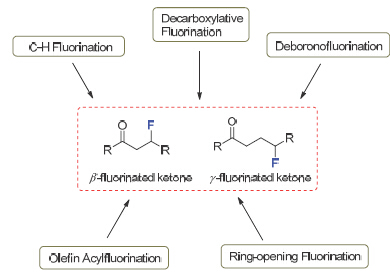| [1] (a) Hiyama, T. Organofluorine Compounds: Chemistry and Applications, Springer, New York, 2000.
(b) Kirsch, P. Modern Fluoroorganic Chemistry: Synthesis, Reactivity and Applications, 2nd ed., Wiley-VCH, Weinheim, 2013.
(c) Fluorine in Pharmaceutical and Medicinal Chemistry: From Biophysical Aspects to Clinical Applications, Eds.: Gouverneur, V.; Muller, K., Imperial College Press, London, 2012.
(d) Ni, C.; Zhu, L.; Hu, J. Acta Chim. Sinica 2015, 73, 90. (倪传法, 朱林桂, 胡金波, 化学学报, 2015, 73, 90.)
(e) Zhu, H.; Liu, G. Acta Chim. Sinica 2012, 70, 2404. (朱海涛, 刘国生, 化学学报, 2012, 70, 2404.)
(f) Xiao, Y.; Pan, Q.; Zhang, X. Acta Chim. Sinica 2015, 73, 383. (肖玉兰, 潘强, 张新刚, 化学学报, 2015, 73, 383.)
[2] (a) Miller, P. W.; Long, N. J.; Vilar, R.; Gee, A. D. Angew. Chem., Int. Ed. 2008, 47, 8998.
(b) Ametamey, S. M.; Honer, M.; Schubiger, P. A. Chem. Rev. 2008, 108, 1501.
[3] For selected examples, see: (a) Shibata, N.; Suzuki, E.; Takeuchi, Y. J. Am. Chem. Soc. 2000, 122, 10728.
(b) Hintermann, L.; Togni, A. Angew. Chem., Int. Ed. 2000, 39, 4359.
(c) Hamashima, Y.; Yagi, K.; Takano, H.; Tamás, L.; Sodeoka, M. J. Am. Chem. Soc. 2002, 124, 14530.
(d) Ishimaru, T.; Shibata, N.; Horikawa, T.; Yasuda, N.; Nakamura, S.; Toru, T.; Shiro, M. Angew. Chem., Int. Ed. 2008, 47, 4157.
(e) Kwiatkowski, P.; Beeson, T. D.; Conrad, J. C.; MacMillan, D. W. C. J. Am. Chem. Soc. 2011, 133, 1738.
(f) Wang, L.; Meng, W.; Zhu, C.-L.; Zheng, Y.; Nie, J.; Ma, J.-A. Angew. Chem., Int. Ed. 2011, 50, 9442.
(g) Phipps, R. J.; Hiramatsu, K.; Toste, F. D. J. Am. Chem. Soc. 2012, 134, 8376.
[4] (a) Liu, W.; Groves, J. T. Angew. Chem., Int. Ed. 2013, 52, 6024.
(b) Huang, X.; Liu, W.; Ren, H.; Neelamegam, R.; Hooker, J. M.; Groves, J. T. J. Am. Chem. Soc. 2014, 136, 6842.
[5] (a) Bloom, S.; Pitts, C. R.; Woltornist, R.; Griswold, A.; Holl, M. G.; Lectka, T. Org. Lett. 2013, 15, 1722.
(b) Bloom, S.; Sharber, S. A.; Holl, M. G.; Knippel, J. L.; Lectka, T. J. Org. Chem. 2013, 78, 11082.
[6] Xia, J.; Zhu, C.; Chen, C. J. Am. Chem. Soc. 2013, 135, 17494.
[7] Kee, C. W.; Chin, K. F.; Wong, M. W.; Tan, C. H. Chem. Commun. 2014, 50, 8211.
[8] Yin, F.; Wang, Z.; Li, Z.; Li, C. J. Am. Chem. Soc. 2012, 134, 10401.
[9] Li, Z.; Wang, Z.; Zhu, L.; Tan, X.; Li, C. J. Am. Chem. Soc. 2014, 136, 16439.
[10] Wang, H.; Guo, L.; Duan, X. Chem. Commun. 2014, 50, 7382.
[11] Zhu, L.; Chen, H.; Wang, Z.; Li, C. Org. Chem. Front. 2014, 1, 1299.
[12] Zhao, H.; Fan, X.; Yu, J.; Zhu, C. J. Am. Chem. Soc. 2015, 137, 3490.
[13] Ishida, N.; Okumura, S.; Nakanishi, Y.; Murakami, M. Chem. Lett. 2015, 44, 821.
[14] Ren, S.; Feng, C.; Loh, T. Org. Biomol. Chem. 2015, 13, 5105.
[15] Bloom, S.; Bume, D. D.; Pitts, C. R.; Lectka, T. Chem. Eur. J. 2015, 21, 8060. |
